Category: Reading1
lchi-LookingOutwards01
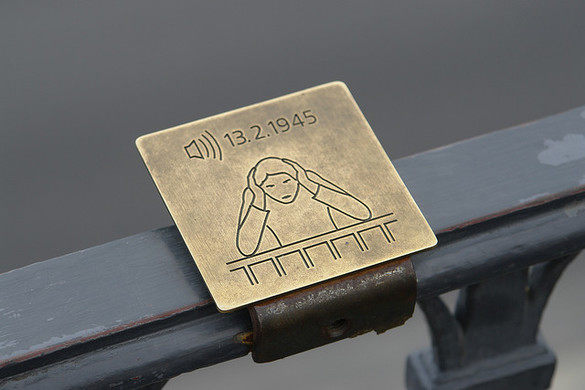

ya-lookingoutwards01
New Nature by Marpi is primarily an interactive exhibition, featuring display panels and surround sound immersing guests in a world filled with virtual creatures – abstract-looking trees, plants, and flowers which react to guests’ presence and hand movements via Kinect and Leap Motion sensors. While the full experience is on exhibit at Artechouse in Washington, DC., accompanying experiences are available as mobile experiences on iOS and Android. The project was a collaboration with Kevin Colorado (technical direction), Bent Stamnes (sound design), Will Atwood (3D art), with documentation by Daniel Garcia and Jeremy Shanahan. New Nature was made using Unity, in conjunction with external software for Kinect and Leap Motion.

I admire the procedural nature of the generative plants and creatures, as well as the physical, tactile nature of “touching” the creatures with your hands. As a person working within Augmented and Virtual Reality, I am also interested in exploring this physicality of virtual objects. Having virtual objects react to your movement through sensors adds a level of involvement and connection to the virtual work that would not otherwise be possible.
dorsek- Reading1
Ahhh – of Flanagan’s propositions I believe that the one which most closely aligns with my own goals as an artist at the moment would likely be the third one (particularly with the senior project I’ve been working on) though I am interested greatly in a key aspect of what seems to define the second proposition (namely the idea of play itself acting as a medium for a type of subversion and the idea of ignoring play-ability which is refreshingly at odds with my practice in HCI).
I don’t really understand yet or have a broad category to define what I am criticizing just because that seems to me to be something so fluid at the moment that it’s ultimately quite silly to try and define, but I gravitate towards the concept of again utilizing clever user experience design ideas in order to engage in an interactive piece. In particular I think that using this as a means of encouraging users to dwell on an experience of play and “find new meaning in the changes in interaction and experience that critical play provides” (page) as Flanagan puts it just about sums up my reason for interest in creating pieces that engage in this narrative.
Jamodei-reading1
When Flanagan states, “[g]ames—like film, television, and other media—are created by those who live in culture and are surrounded by their own cultural imaginary, and are a cultural medium that carries embedded beliefs, whether intended or not,” I hear what I consider to be an echo of (one of) my foundational questions when I begin a new art project. What do I want to explore, and why? How are the potential proposed aesthetics and politics interpellating each other? Why does the medium I am using matter to the experience of the viewer/participant who will encounter it? What expectations will the framework of the location of the work leave the viewer to start with? What will their relationship to my viewpoint offer them? What process, what method, and to what end?
The exposition or complication of a norm or idea is often the hope, or maybe even goal, in work I make or projects for which I design theatrical environments. I was excited to encounter this idea in relation to the making of art-games, to which I am only relatively recently exposed. Flanagan’s third point – concerning employing criticality to create new forms of play – was immediately recognizable to me in terms of a technique which interests me in performance mediums (including the digital). It made me think further about the ‘double-performance.’ An example of this Postdramatic technique could be summarized as when a theater production uses a live camera onstage, but forefronts the interplay between the filming, the filmed, and the live (re)mediation of the filmed. This multifaceted liveness tells an audience member who might be accustomed to sitting in the dark watching a narrative scene unfold that they have multiple points of reproduction to track at at the same time. Often, my hope with this technique is that the disruption of how the audience is supposed to pay attention to the form comes under question as the content of the production unfolds, and hopefully in the in between spaces of interpreting the double (or triple depending on how you want to look at it) performance new ways of experiencing the idea can be accessed. I think there are a lot of intriguing possibilities for considering how new forms of play relate to attention, and how such relationships help convey the transfer of specific critiques of dominant (or assumed) values.
dorsek – Looking Outwards -1
Born from a curiosity in a want to understand our physicality in a such a heavily digitally developed world; It wavers between being human or merely representational and as such is intended to confuse the user, from afar and in person the piece seems to err on the genre of hyperrealist painting and it’s not until the viewer lingers for awhile with it that they begin to notice the “painting” slowly breathe, twitch, and blink.
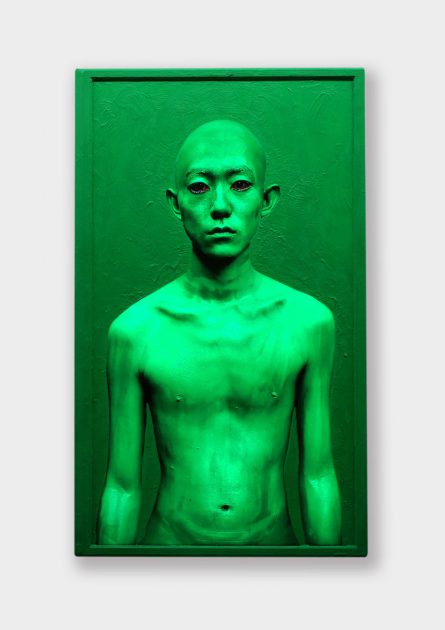
When you boil it down the piece is a video of a shaved, nude, monochromatically painted individual on an LCD monitor painted the same shade. Funny enough nothing about this “new media” artwork is actually new… process wise there’s a poetic simplicity in how it combines technology & “fine art” (which I think is one of the main reasons I gravitate towards it so much as a point of inspiration), and reflects on a history of art that questions explores the presence of the individual/human brewing in an environment saturated with technology.
** If I had the opportunity to work on this piece, I would try to play a little more with this space between human & representation; engage with the audience in a way that further intensifies this feeling of confusion using through the interface and feedforward perhaps based in various monitoring technologies (but maybe that’s the easy answer?) – on that note presently it seems to me to be noteworthy for being as interactive as it is without any programming to stimulate/simulate engagement.

VIDEO:
arialy-reading1
I definitely find relatability in all three propositions, but I would pick the second as the most aligned with my goals. To simplify, I understood each proposition to focus on one part of the work– 1. the choices made in during the experience, 2. the goal/ending, 3. the mechanics. For the first, I’m not that focused on viewer agency and have yet to create work with real choices. I have been interested in employing unusual mechanics in my work and therefore can relate to the third, but I believe the goal of the viewer (and piece) is the most important part of my art. While for me novel mechanics can sometimes be a very useful means to an end, I believe the underlying message of my work is best perceived through the viewer’s objective and therefore engagement with the experience.
arialy-lookingoutwards1
Graffiti Nature – teamLab
Graffiti Nature is an exhibition in teamLab’s Borderless Museum. After coloring in either an animal or flower outline with crayons, your drawing will be scanned in and then projected onto the floor. Your creature comes alive and can walk around, but people can also step on it and eventually kill it.
teamLab is a Tokyo-based company of ~600 people (though the technical department is much smaller). One interactive team member takes on the bulk of the work per project (and coordinates with other departments). The projects are made predominantly in Unity, and are created over the course of a few months.

^ My creature!

^ Strangers, both adults and kids, intentionally stepped on my creature ;-;
I really enjoy how the project transforms the common coloring book experience, giving both kids and adults the chance to bring their drawings to life (with no shame to those bad at drawing). I was however quite surprised by the darker side of this project and a few other teamLab works (you can burn little people in another kids’ project, and the animals covered in flowers in the hallways will die if you remove all the flowers on them). Creating death complicates an otherwise utopic world and pushes it more towards reality, but part of me wishes there was more consequence to the virtual murder of my baby creature.
lumar-reading1
I had plenty of ideas for the 2D physics exercise before reading Flanagan’s on critical play. Now, I’m a little strapped for ideas. Reading about her analysis was a good catalyst for self-reflection; all my ideas seemed like interesting bits of micro interactions afterwards.
In trying to break down and reflect on Flanagan’s points, I show how I think her points fit within/relate to my existing mental schema of “making” or “prototyping” —
— Namely that (in a somewhat reductionist diagram shown below), there are three distinct points that represent the different types of purposes/goals behind a prototype. Prototypes of varying fidelity occupy different points in the area of that triangle.
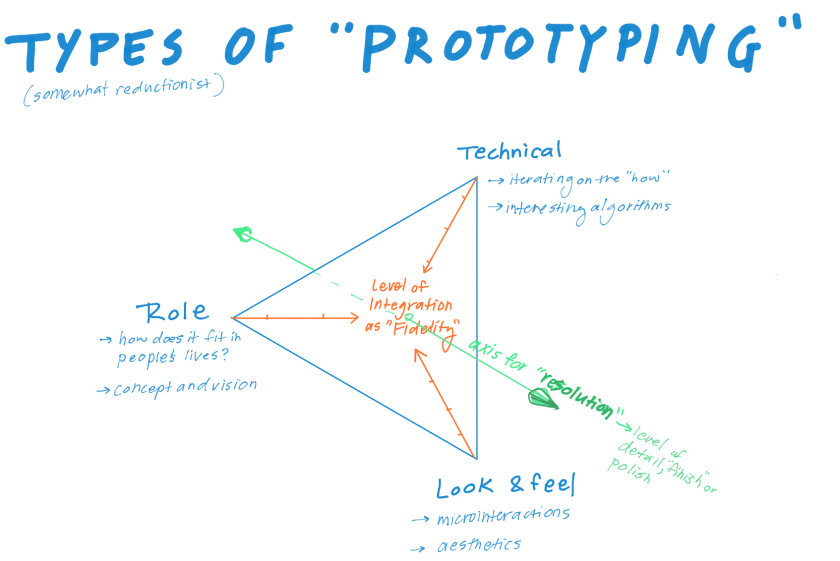
So given the above (my mental model as informed by a paper by Gomoll), I tried to make sense of Flanagan’s points in that context and show how her points have also added to my mental model.
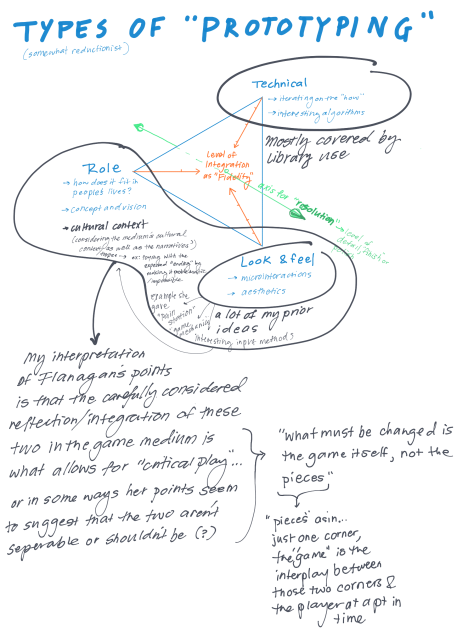
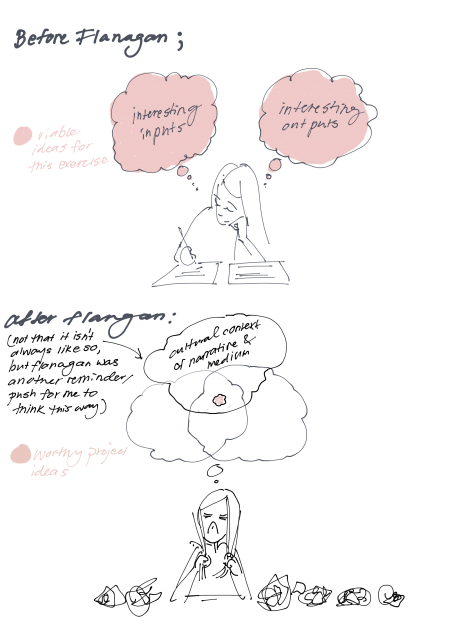
lumar-lookingoutwards01
“Think about an interactive artwork…which you find inspirational”
Wow. Choice paradox much? How does one choose? And what does it mean to be inspirational for me? Because there are many different types, and I feel the need to break that down.
Some interactive work I find inspirational because there’s an aspect that I want to be able to grow towards — to aspire to (whether it be high level of craft, narrative, execution), but that doesn’t mean that I find the project as a whole to be inspired.
There are pieces I admire for being outstanding and brilliant as “last word” art, but I don’t know if they have as much power moving the collective intellect or emotional landscape — which I might argue is more important to “inspired” work. (Why might I say that? Well, I’m personally very bored by modern photorealistic paintings. My first impression of them is just that they showcase the artists’ “outstanding” technical skill at observation and representative replication, but most of the initial feeling of ‘awe’ from the audience feels cheaply won because it’s not unique to the piece….simply a byproduct of admiration for that general skillset…and it’s skill in a technique that isn’t novel or niche anymore.)
And then I wonder, how does my choice here reflect on what I prioritize?
Lol. I hope no one reads too deeply into it— so here is me showing that I’ve reflected on the assignment…and then discarded my musings because it’s just the first looking outwards assignment, thus I should take a chill pill and save my words for the actual juice, so here goes:
I love their craft. This is the level of work I aspire to.
INORI (Prayer) from nobumichi asai on Vimeo.
I find it inspirational because, well yes, a lot of the initial value might be the wow factor of the super fast tracking and projection (latency in the milliseconds!) but it takes advantage of the technology to create a dance that has great rhythm (visual and otherwise) and surrealism. The mixing of the dancer’s physical features with the virtual projections as a design choice does well to augment the ‘surrealism’ that comes with an emerging/or fairly novel technology.
This is how it was made:
INORI (prayer) / Making from nobumichi asai on Vimeo.
Does it move me emotionally? Sure, as much as any well executed dance or film piece might. But intellectually?…..perhaps, but it’d be subtle and I’d have to really take the time to reflect on why this piece was appealing to figure that out. It certainly isn’t nearly as obvious an answer as say…
..this “AI artwork” that sold for half a million at Christie’s Auction:
A-collaboration-between-two-artists-one-human-one-a-machine
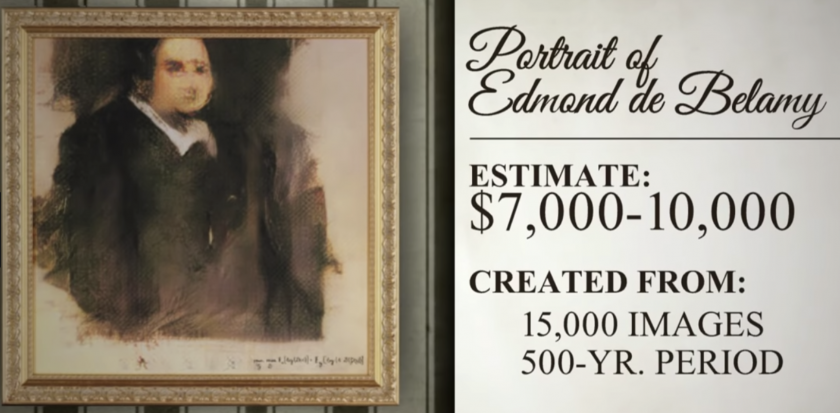
Instead of a painter’s author signature, in the corner is an innocuous math formula.
These pieces raises a lot of questions that I don’t have answers to immediately. The French artist collective, “Obvious” reaped the monetary acknowledgement of ‘authorship’ but they didn’t write the code that made the AI. A lot of it is built of Google’s research and some American developers GitHub (that they also didn’t credit)
Not to mention, they most definitely aren’t the first of their kind as they seem to claim.
Ok, So what is their time and effort put into this considered if not authorship? I wouldn’t give the artistic or creative credit to the AI, because there was no initiative behind it without a person driving it’s efforts. Someone put thought behind the data set this was trained on (old master paintings) and while the exact results weren’t things the artist might have thought of explicitly, they aren’t exactly unexpected either are they? But then that also raises an interesting point….were the artists then simply curators? But by that logic, they didn’t author this, they censored a generator, and were awarded for having some degree of taste. For training the AI, are they simply the biological bootloaders for the actual creator? The AI? I wouldn’t necessarily say that either…because regardless of authorship or creative drive, I feel at least comfortable to say I”d agree that they are responsible for this instance of an image modeled like an old master’s painting and ‘signed’ by a formula in Christies’ gallery.
Perhaps its the context that makes it art? That one would take this instance with its unique process outside of the niche corners of Twitter (with plenty of creators in this medium that have arguably better technique and novel work ex:Mario Klingemann) and frame it as if it were last word art in one of the art world’s most prestigious auctions?
From that perspective…there are, at least on the surface, strong parallels with the Ready-Made pieces of Dada artists.
hmm…..welp. Things to think about. Either way I’m glad this piece did what it did, even if the artists felt more like hype marketers because it’s interesting to think about and sometimes it really is just about asking the interesting questions and making others do that too.
…..certainly it’s done more to move people than any of my piece so.
….
yeah so please enjoy this and come talk to me about your thoughts on this topic! Maybe this whole thing is just semantics but those are important to finesse too!